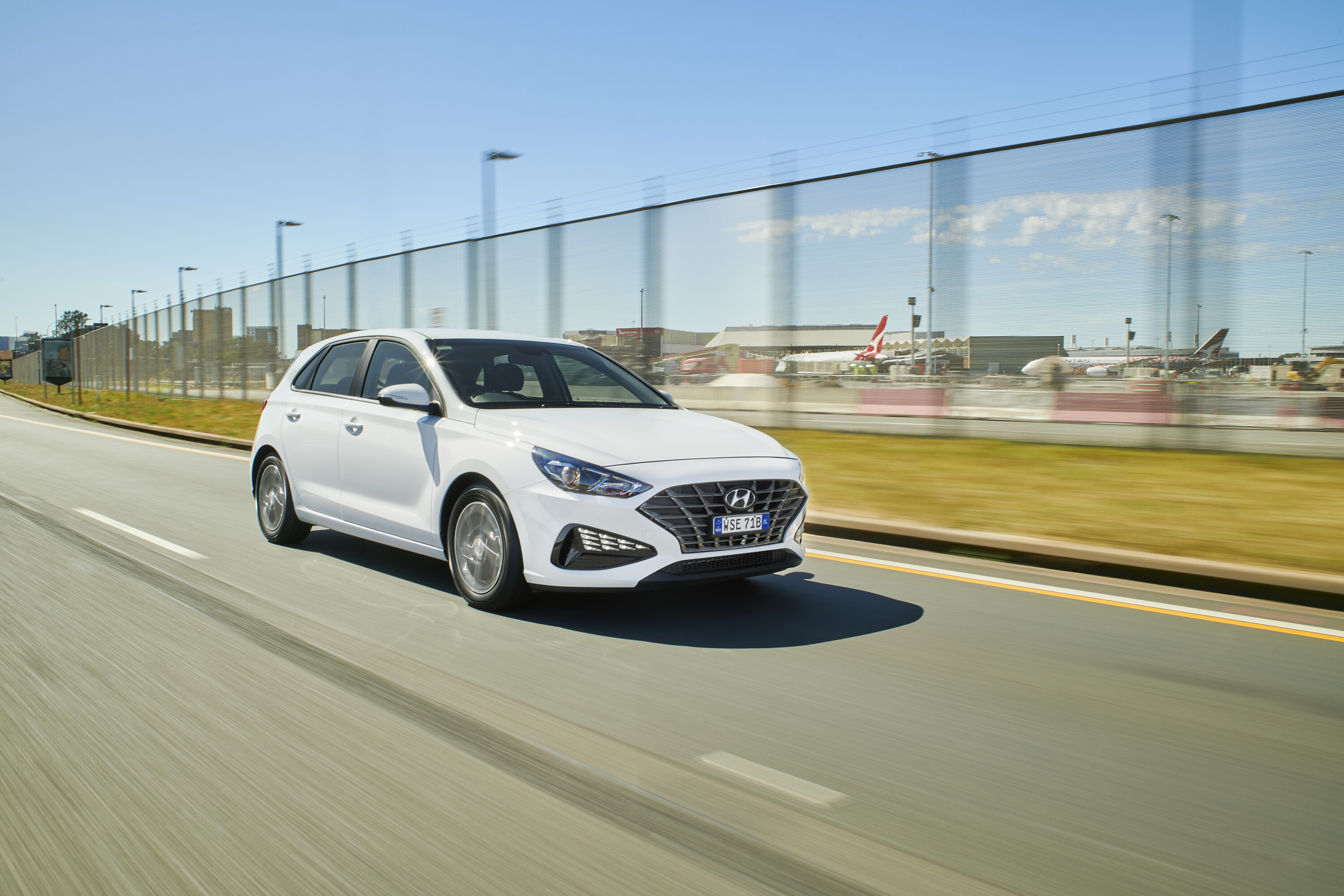
Score breakdown
Things we like
- Ride and handling
- Smooth powertrains
- N-Line and N performance
- Manual gearbox not confined to entry-spec
Not so much
- Tight rear legroom
- No wireless Android Auto/Apple CarPlay
- Lacks some of the newer active safety features
The Hyundai i30 is Australia’s most popular passenger car.
With a broad choice of hatch and sedan models, the Hyundai i30 more than matches the venerable Toyota Corolla in terms of popularity and value.
The stylish i30 range is loaded with equipment, including great smartphone integration and – on more expensive versions – a broad active safety suite that includes autonomous emergency braking.
Handling and comfort are good, and there is a broad range of models ranging from the budget-priced eponymous hatchback to the i30 N hot hatch and sedan.
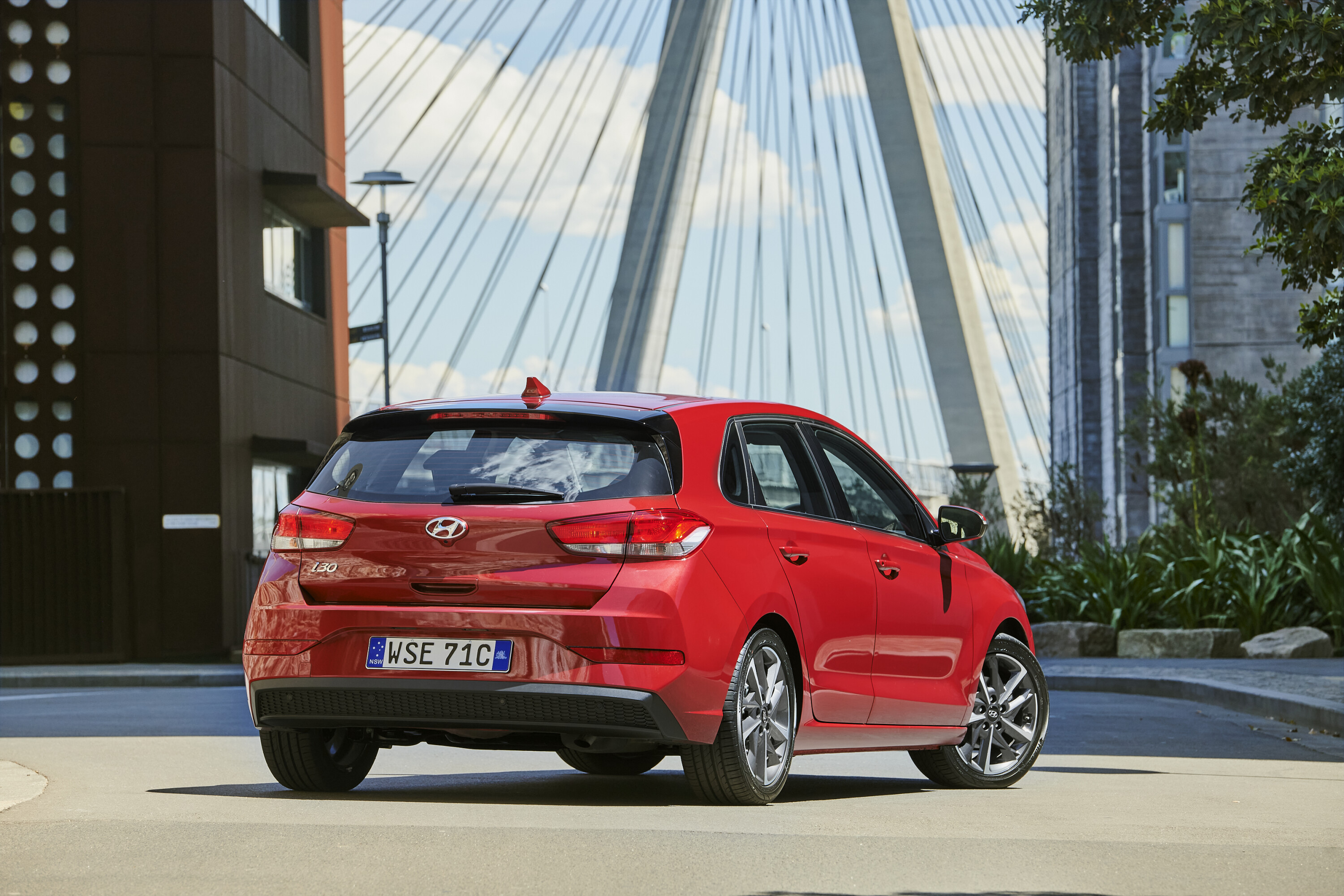
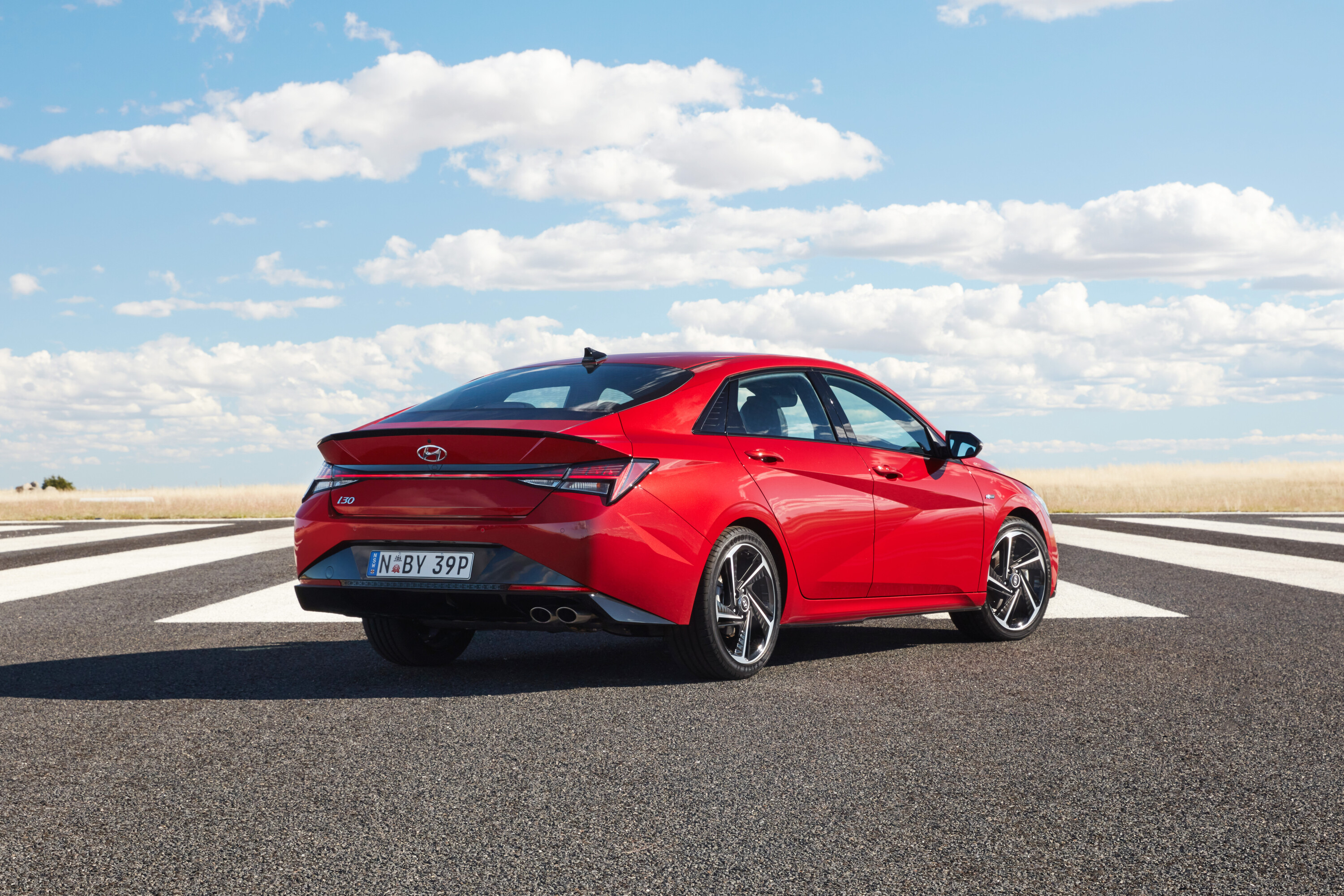
JUMP AHEAD
- Hyundai i30 pricing
- What body styles are there?
- What features are in every i30?
- What key features do I get if I spend more?
- How safe is the Hyundai i30?
- How comfortable & practical is the i30?
- Rear space & comfort
- How much boot space does the i30 offer?
- I like driving, will I enjoy the i30?
- Which Hyundai i30 engine uses the least fuel?
- What is the Hyundai i30’s towing capacity?
- How long is the warranty & what are the i30’s servicing costs?
- Which version of the i30 does Wheels recommend?
- What are the i30’s key rivals?
It’s worth noting the differences between the i30 hatchback and sedan extend well beyond the sheet metal – they’re built on different platforms, and the sedan is still known overseas as the Elantra.
The third-generation i30 hatchback was first introduced in 2017 and is nearing the end of its lifecycle. Meanwhile, the fresher sedan is actually a seventh-generation Elantra but was given an i30 badge in Australia when it arrived in 2021.
It’s no secret Hyundai made the name change to outdo other hatch/sedan rivals such as the Corolla, Mazda 3 and Kia Cerato on the sales charts.
The i30 nameplate is now the most popular non-SUV or ute in Australia, so it shows the decision was a no-brainer in an industry where bragging rights mean everything.
2023 Hyundai i30 pricing
| Variant | Price (before on-road costs) |
|---|---|
| i30 hatchback manual | $24,000 |
| i30 hatchback auto | $26,000 |
| i30 Active sedan manual | $26,000 |
| i30 Active hatchback auto | $27,500 |
| i30 Active sedan auto | $28,000 |
| i30 N-Line hatchback manual | $30,500 |
| i30 Elite hatchback auto | $30,800 |
| i30 Elite sedan auto | $32,000 |
| i30 N-Line sedan manual | $32,000 |
| i30 N-Line hatchback auto | $32,500 |
| i30 N-Line sedan auto | $34,000 |
| i30 N-Line Premium hatchback manual | $35,300 |
| i30 N-Line Premium hatchback auto | $37,300 |
| i30 N-Line Premium sedan auto | $39,000 |
| i30 N hatchbach manual | $46,200 |
| i30 N hatchbach auto | $49,200 |
| i30 N Premium hatchback manual | $49,200 |
| i30 N Premium sedan manual | $50,200 |
| i30 N Premium sedan auto | $50,200 |
What body styles are there?
The i30 is available as a five-door hatchback or four-door sedan.
All variants are front-wheel drive and the nameplate competes in Australia’s sub-$40,000 small passenger car segment.
What features are in every Hyundai i30?
| 2023 Hyundai i30 standard features | |
|---|---|
| Wired Apple CarPlay/Android Auto | AM/FM radio |
| USB sockets | Infotainment touchscreen |
| Blutooth connectivity | Leather-appointed steering wheel |
| Digital guage cluster | Air-conditoning |
| Cruise control | Reversing camera |
| Rear parking sensors | Dusk-sensing headlights |
| LED daytime running lights | Hill-start assist |
| Illuminated vanity mirrors | LED indicator lamps |
| Heated auto-folding exterior mirrors | Driver’s seat height adjustment |
| Seatbelt reminders | Autonomous emergency braking |
| Tyre pressure monitor | Seven airbags |
| Blind-spot monitoring | Emergency stop signal |
| Lane following assist | Lane-keeping assist |
| Keyless entry | Driver attention monitor |
| Alloy wheels | |
What key features do I get if I spend more?
The basically named entry-level i30 hatchback comes with a 2.0-litre four-cylinder petrol engine and six-speed manual gearbox as standard.
Spending an additional $2000 brings a six-speed automatic transmission. As well as a self-shifting gearbox, the extra money brings adaptive cruise control and selectable drive modes with Normal, Eco and Sport settings.
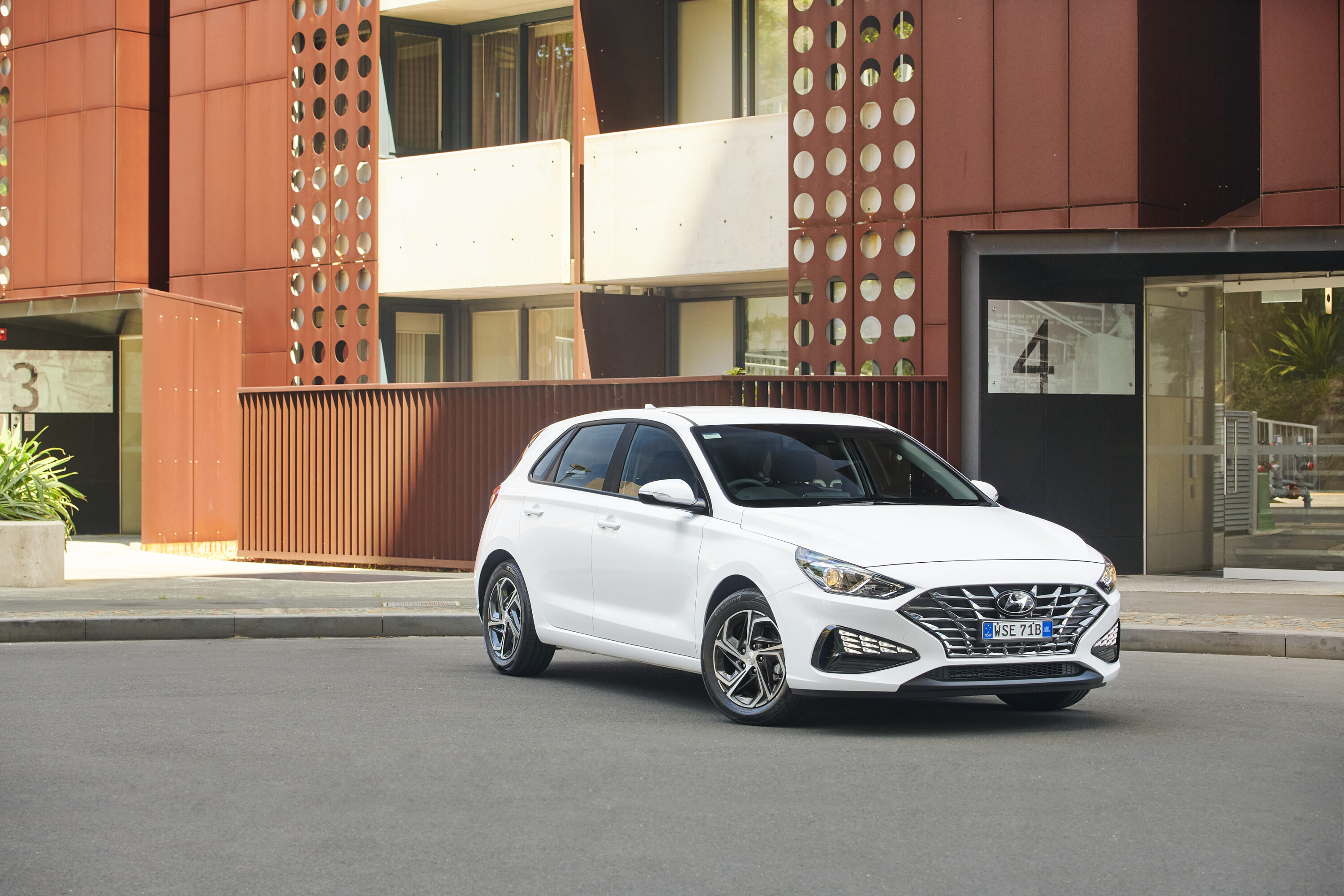
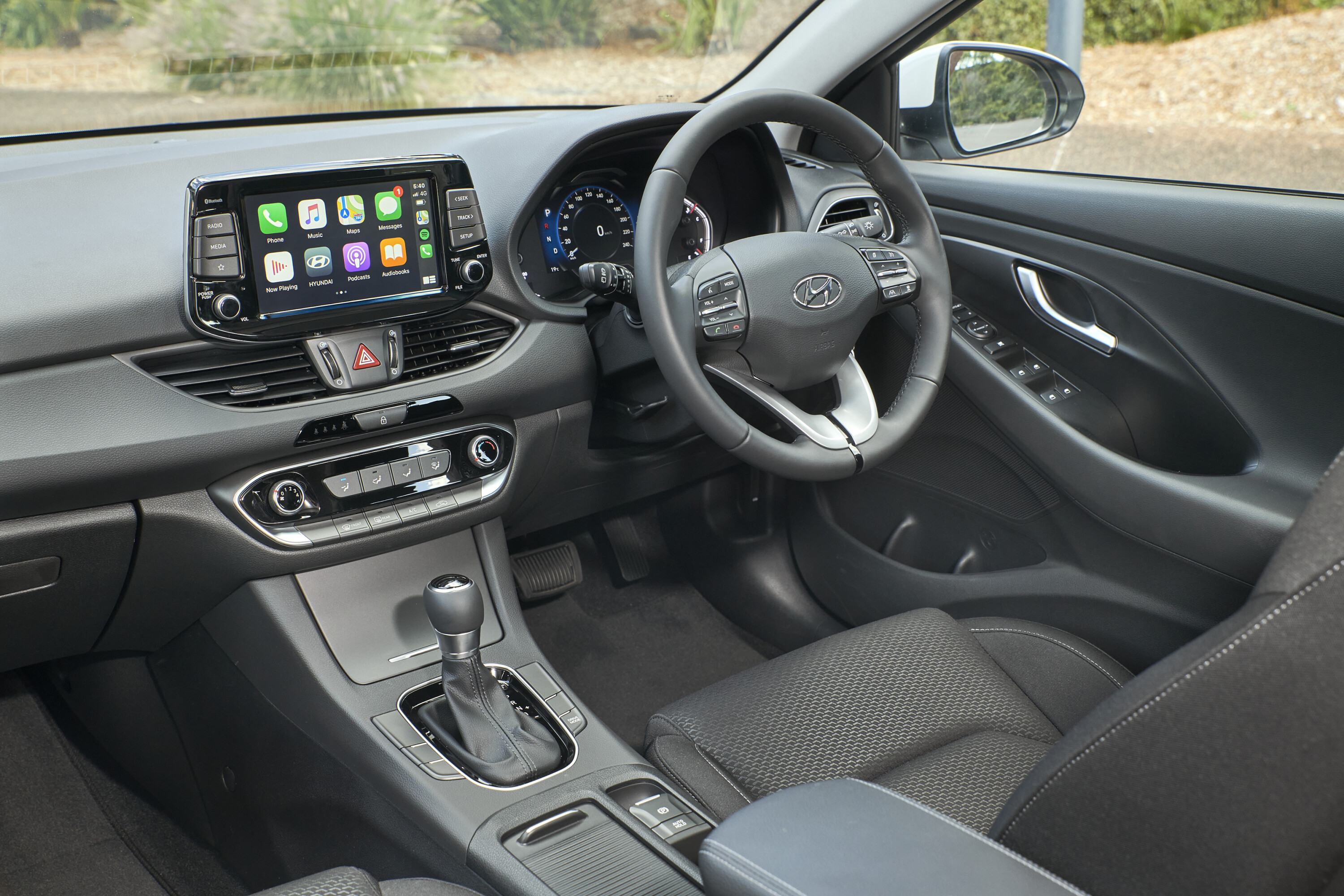
The i30 hatchback is equipped with cloth seats, a six-speaker audio system, 16-inch alloy wheels and a full-size alloy spare.
Stepping up to the Hyundai i30 Active brings a choice of hatch and sedan, which are both available with similar 2.0-litre manual and automatic powertrains.
The sedans respectively cost $2000 and $1500 more than their manual and automatic hatchback counterparts.
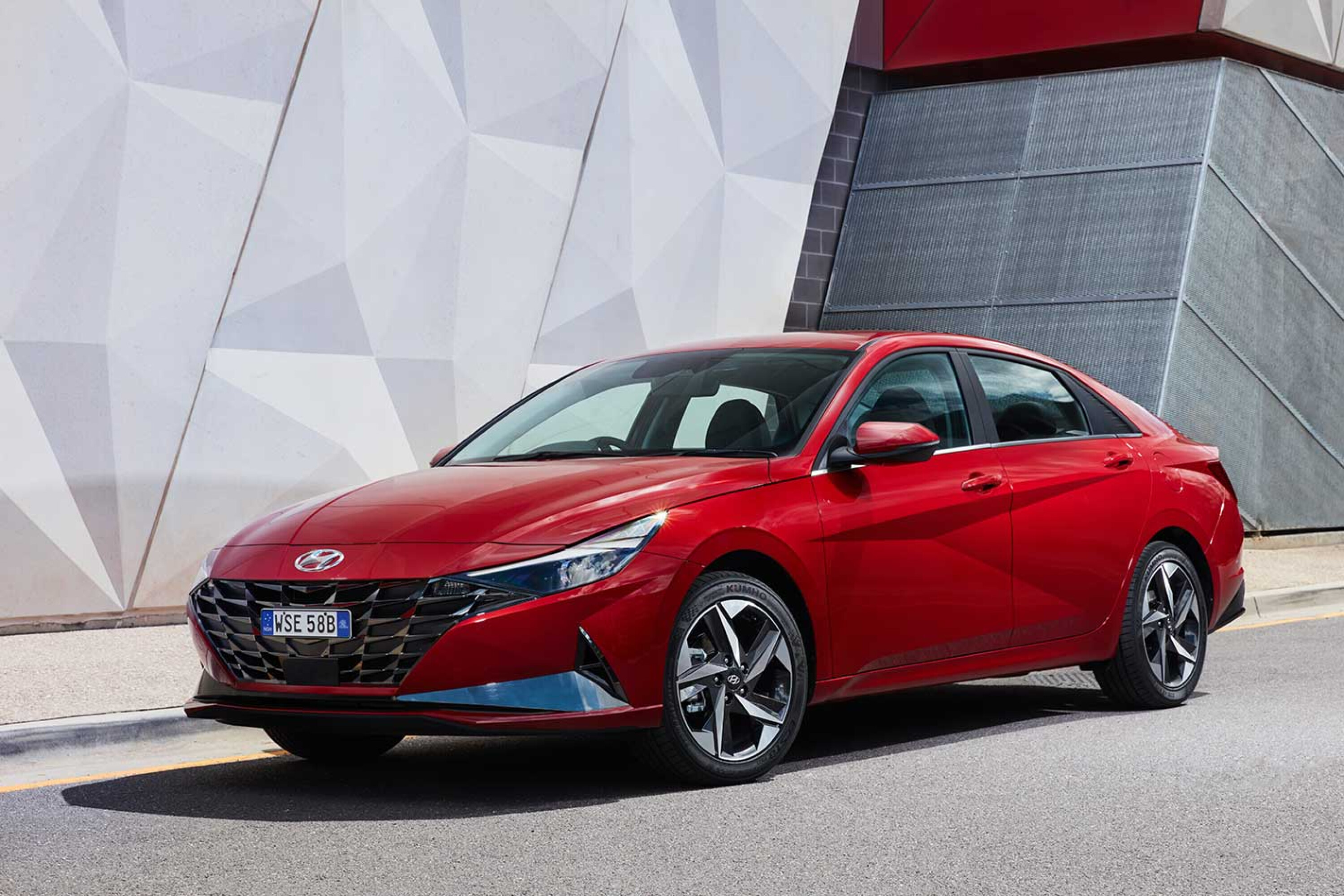
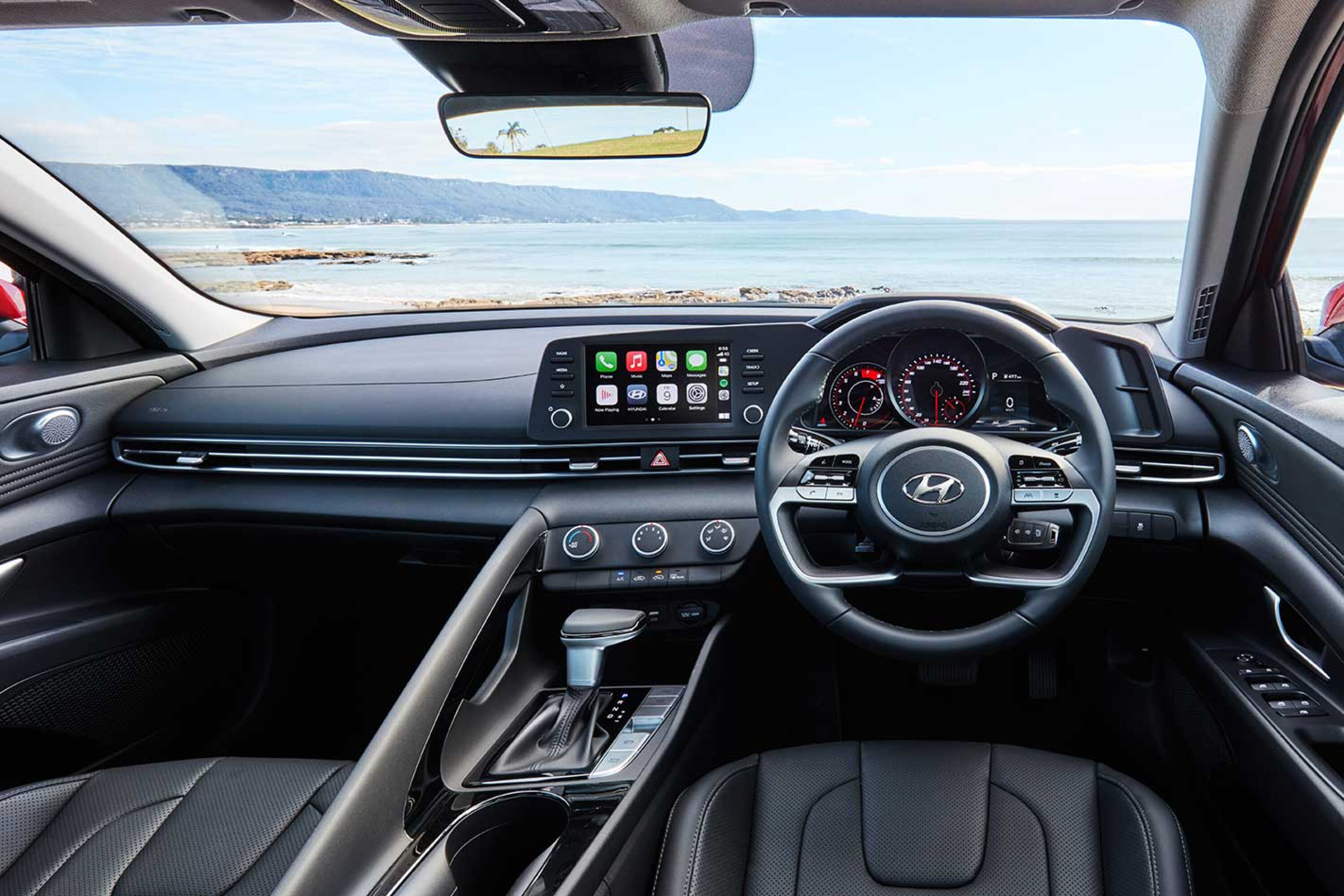
While they are quite different cars, the hatchback and sedan are very similarly equipped, though the sedan’s interior looks considerably fresher.
Additional features in the Active over the entry-level i30 spec include:
| 2023 Hyundai i30 Active additional features | |
|---|---|
| Leather-appointed seats | LED dashboard ambient lighting |
| Electronic parking brake (auto only) | Wireless charging pad (sedan) |
| 17-inch alloy wheels | |
The elegantly styled Hyundai i30 Elite is only available with the automatic transmission and adds:
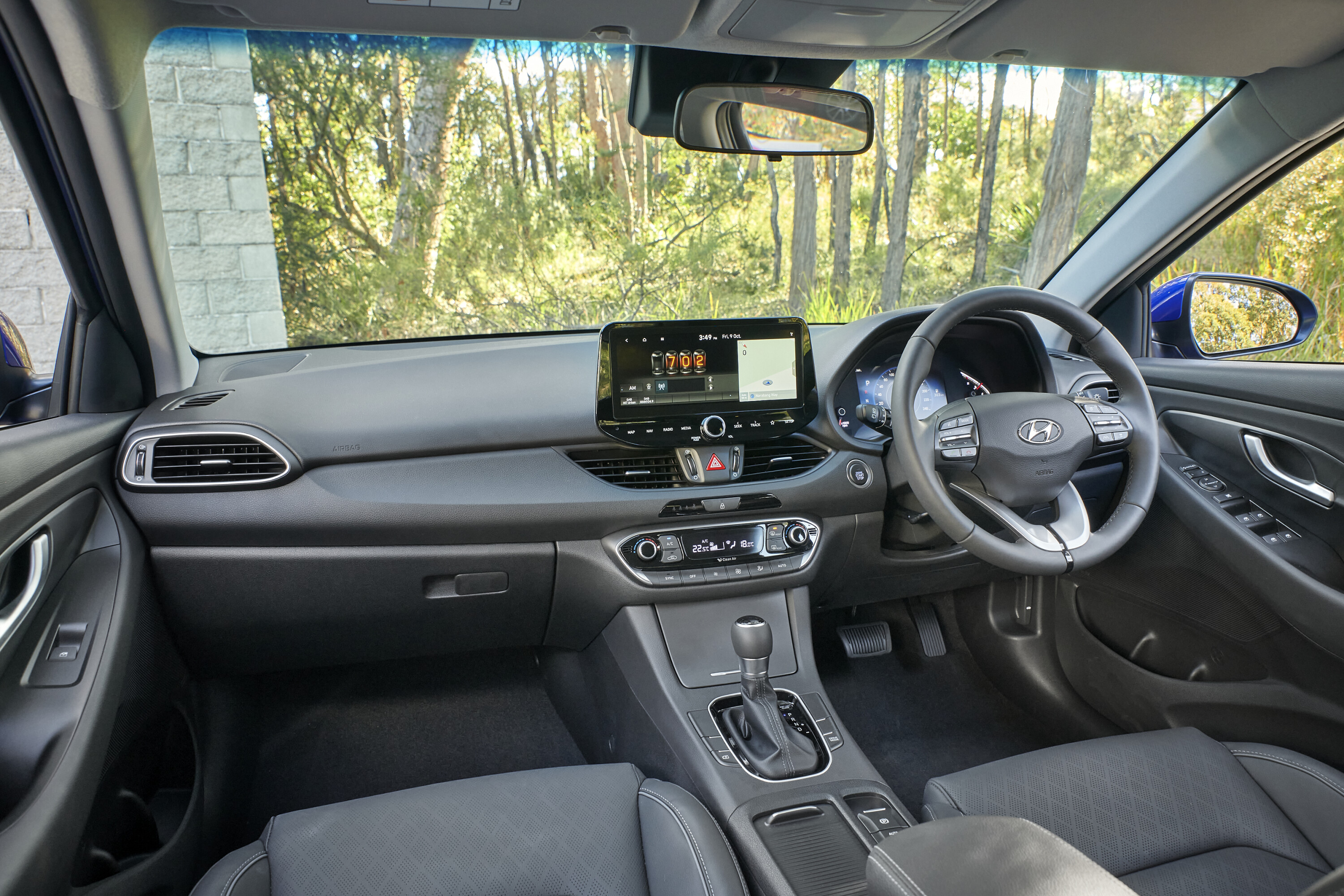
| 2023 Hyundai i30 Elite additional features | |
|---|---|
| 10.25-inch touchscreen | Rear cross-traffic alert |
| Rear-view monitor with parking guidance | Smart key |
| Push-button start | Blind-spot collision avoidance |
| Satellite navigation | Rain-sensing wipers |
| 7-speaker premium audio | Digital radio (DAB+) |
| Wireless charging pad (hatchback) | Ioniser air purifier |
The Hyundai i30 N-Line is similarly priced to the Elite but is the more athletic of the two, with a punchy 1.6-litre four-cylinder turbo-petrol engine and choice of six-speed manual and seven-speed dual-clutch automatic gearboxes, and sporty trim.

Opting for the sportier N-Line means losing a few of the Elite’s bells and whistles including the bigger touchscreen, sat-nav, digital radio, and the premium audio.
But you do gain Australian-tuned sports suspension, as well as sporty interior and exterior garnish that largely mirrors the i30 N performance car, plus:
| 2023 Hyundai i30 N-Line additional features | |
|---|---|
| Bolstered sports front seats | Paddle shifters (auto only) |
| Dual exhaust tips | Stitched leather trim |
| Sports steering wheel | LED headlights |
| LED rear combination lights | Blind-spot collision avoidance (auto only) |
| High-beam assist | 18-inch alloy wheels |
The Hyundai N-Line Premium has all that along with a few niceties, some of it shared with the Elite, such as:
| 2023 Hyundai i30 N-Line Premium additional features | |
|---|---|
| Front parking sensors with guidance display | Satellite navigation |
| The 10.25-inch touchscreen | Digital radio (DAB+) |
| 10-way power adjustable driver’s seat | 7-speaker premium audio |
| Panoramic sunroof | Heated and ventilated front seats |
Beware: spending an additional several thousand dollars on the Hyundai i30 N doesn’t bring much by way of extra creature comforts or trim upgrades – and you lose adaptive cruise control.
Of course, that’s not why you buy the N. With this one, you get grin-inducing performance and handling plus plenty of enhancements to the chassis and under the bonnet.
These include the powerful 206kW/392Nm 2.0-litre four-cylinder turbo-petrol engine, which comes with a choice of six-speed manual and eight-speed dual-clutch transmissions.
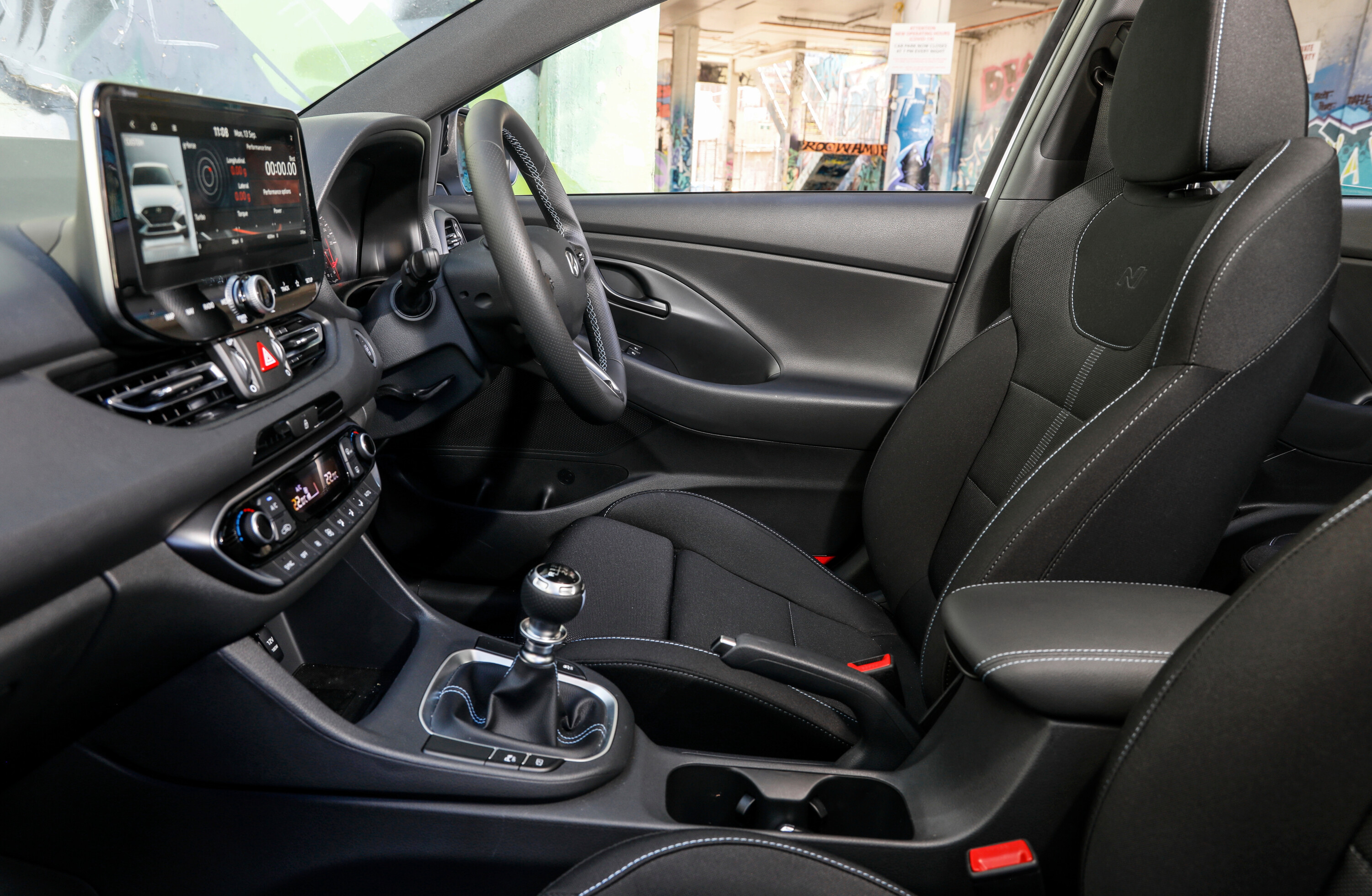
The base i30 N is only available as a hatchback. It is similarly equipped as the i30 N-Line, but gains:
| 2023 Hyundai i30 N additional features | |
|---|---|
| 19-inch alloy wheels | Pirelli P Zero sports tyres |
| Launch control | Temporary space-saver spare wheel |
| 5-stting N Drive Mode System (Eco, Normal, Sport, N, N Custom) | |
| N Grin Shift (NGS), N Power Shift (NPS), N Track Sense (NTS), Creep start | |
| Sports gauges: lap/acceleration time, g-force meter, power/torque/turbo boost | |
Stepping up to the Hyundai i30 N Premium brings the sedan option and similar kit to the N-Line Premium but loses the sunroof. If you want the sunroof you can opt for the aptly named i30 N Premium with Sunroof for an extra $1575 (hatch) and $2100 (sedan).
How safe is the Hyundai i30?
The i30 hatchback has a five-star ANCAP safety rating that was awarded when the third-generation model arrived in 2017.
Curiously, the sedan has no ANCAP safety rating because, with no European NCAP crash test data to draw upon and changes in crash testing protocols, Hyundai decided not to submit the car for costly ANCAP testing, despite a large number of cutting-edge safety inclusions.
Hyundai Australia naturally insists it is safe and with its suite of active safety features together with the fact few Hyundai models have had issues with ANCAP testing, it’s reasonable to take the company’s word for it.
Every i30 hatchback comes with:
| 2023 Hyundai i30 safety features | |
|---|---|
| 7 airbags – dual front and side, driver’s knee and side curtains | Reversing camera |
| Rear parking sensors | Autonomous emergency braking |
| Blind-spot warning | Lane-following assist |
| Lane-keeping assist | Driver attention warning |
| Adaptive cruise control (auto and non N variants only) | |
From Elite spec and up comes rear-cross traffic alert, blind-spot collision avoidance (auto only) and blind-spot warning (manual), while the N-Line Premium and N Premium have front parking sensors.
Curiously, the hot N hatch and sedan variants don’t have adaptive cruise control.
How comfortable and practical is the Hyundai i30?
The i30 is spacious for a small car and both the hatchback and sedan are comfortable, with their cabins scoring points for finish and presentation.
Because it’s a Hyundai, the infotainment system displays well and is easy to operate. All other controls fall easily to hand and are logically grouped: audio and infotainment on the main display and ventilation lower on the dash.
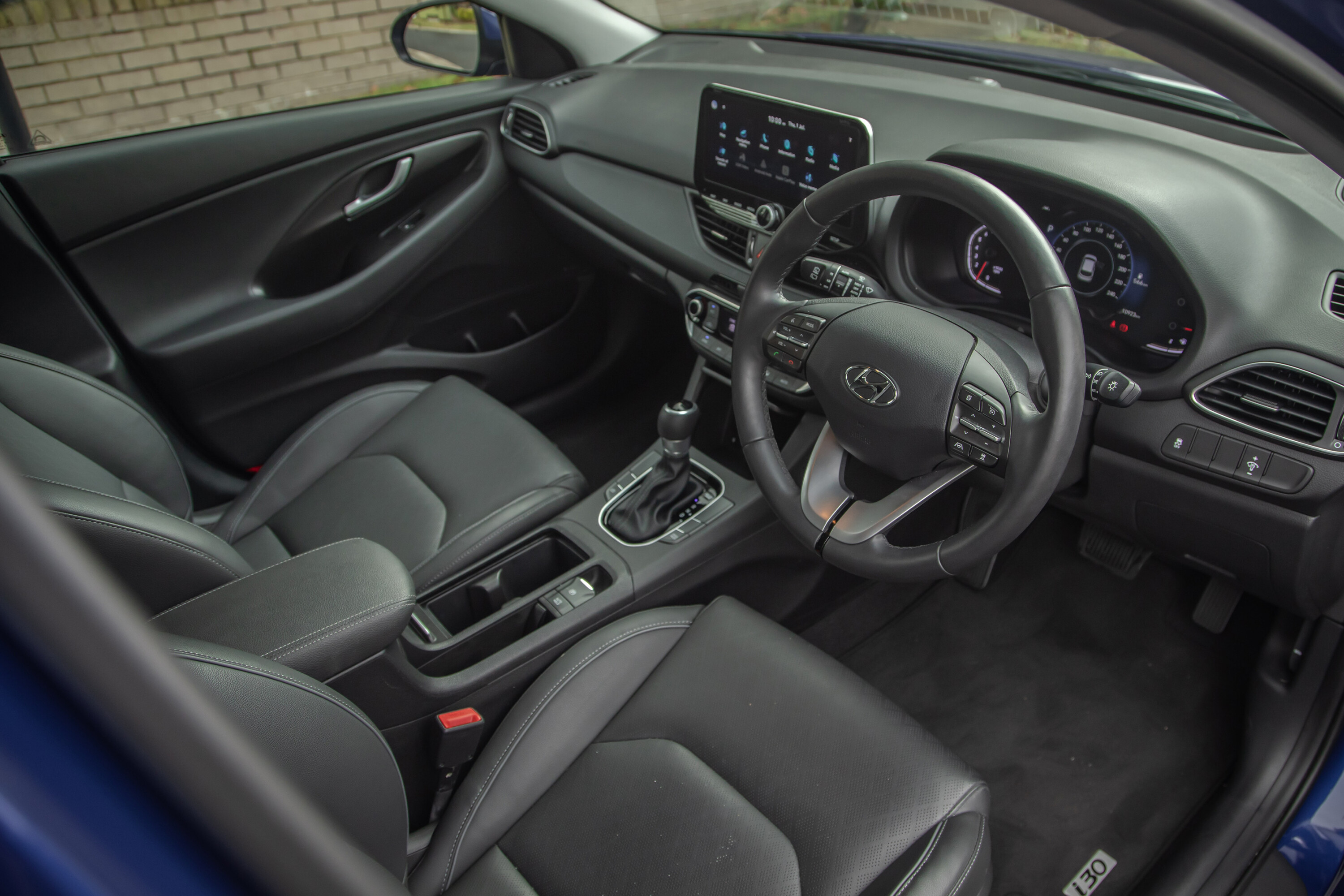
The hatchback has slim bottle holders in the door and two cup holders in the centre console. Automatic variants in Active spec and above don’t have a manual handbrake so the console is uncluttered and everything is easy to use.
A 2021 update brought leather to the steering wheel and gear selector knob, a minor upgrade that yields a huge improvement over the shiny, slippery plastic of the previous i30.
The sedan’s newer cabin design looks a generation younger than that of the hatchback, with a driver-centric dash layout and sweeping lines providing a flowing visual frame at the upper edges.
Its centre console arrangement is also much cleaner and the telescopically adjusted steering wheel sports a horizontal four-spoke design, not unlike Bentleys of old.

However, the cabin seems over-styled to a fault. For instance, the central flying buttress obstructs the passenger’s right elbow from resting on the central armrest. And while the door card shares the attractive sweeping styling with the rest of the cabin, the design penalises storage space.
That said, its overall look and the well-bolstered front seats make it a nice enough place to be. Most touchpoints provide a luxury vibe with leather-like finishes on the steering wheel, gear lever and seats.
Seats are comfortable on all i30 versions, with good lateral support, particularly the sports front seats in the N-Line and N variants.
The i30 N, while bringing a firmer ride to improve handling, loses nothing by way of interior comfort, and when you’re not chasing apexes it makes for a great daily driver.
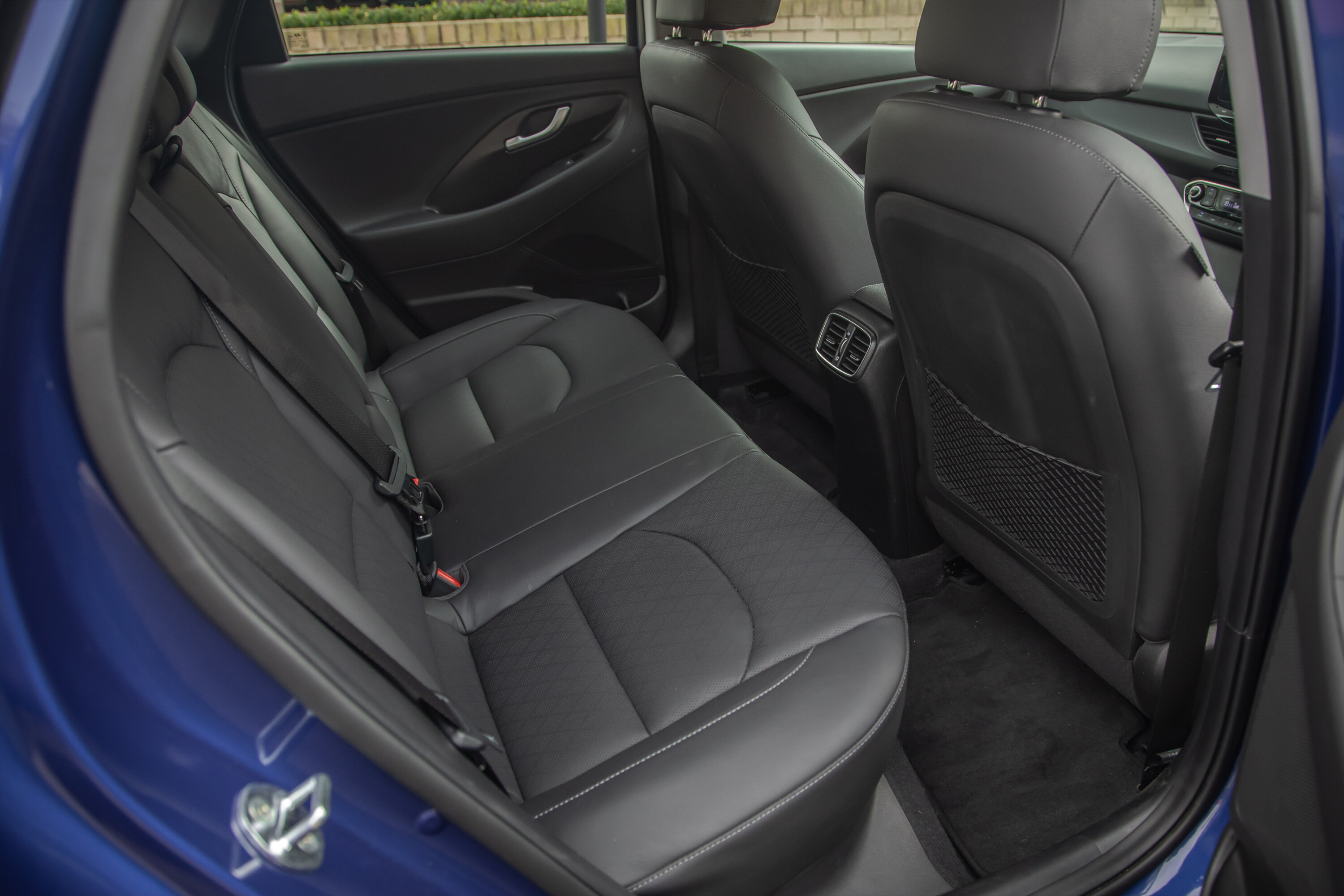
Rear space and comfort
As is common in small hatchbacks, the rear seat is a bit narrow for three but will keep two rear passengers fairly happy.
If you do need to put three in the back, the rear floor is almost flat in the centre and there is space under the front seats for feet.
Someone of average height will fit in the back okay, but it’s not especially comfortable for longer trips as their knees touch the seatback, which has a plastic shield.
The seat is well-shaped without destroying the middle seat, which, as ever, is for smaller folks only.
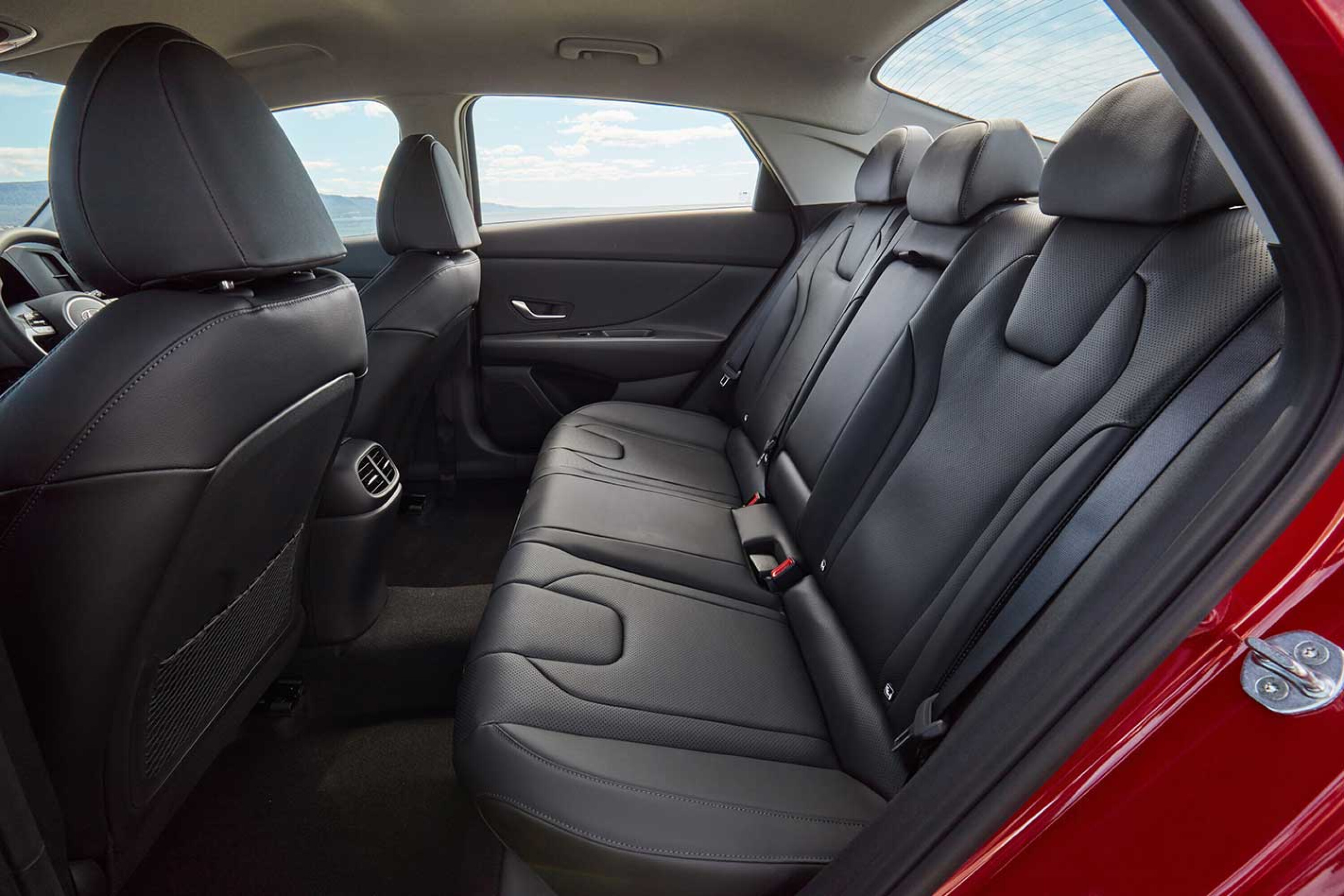
On the plus side, there are air vents in the back and the centre armrest has two cup holders. The doors have slim pockets with a bottle holder but they’re for smaller bottles only.
Because the sedan has a longer wheelbase than the hatch, there’s a lot more rear legroom for passengers.
The rear bench is a bit shapeless but has inserts to try and make it look shapely.
Headroom is surprisingly good, given the sedan’s racy roof profile that falls towards the stubby boot deck. You could get three kids across the back without too much complaining, but short trips are advisable.
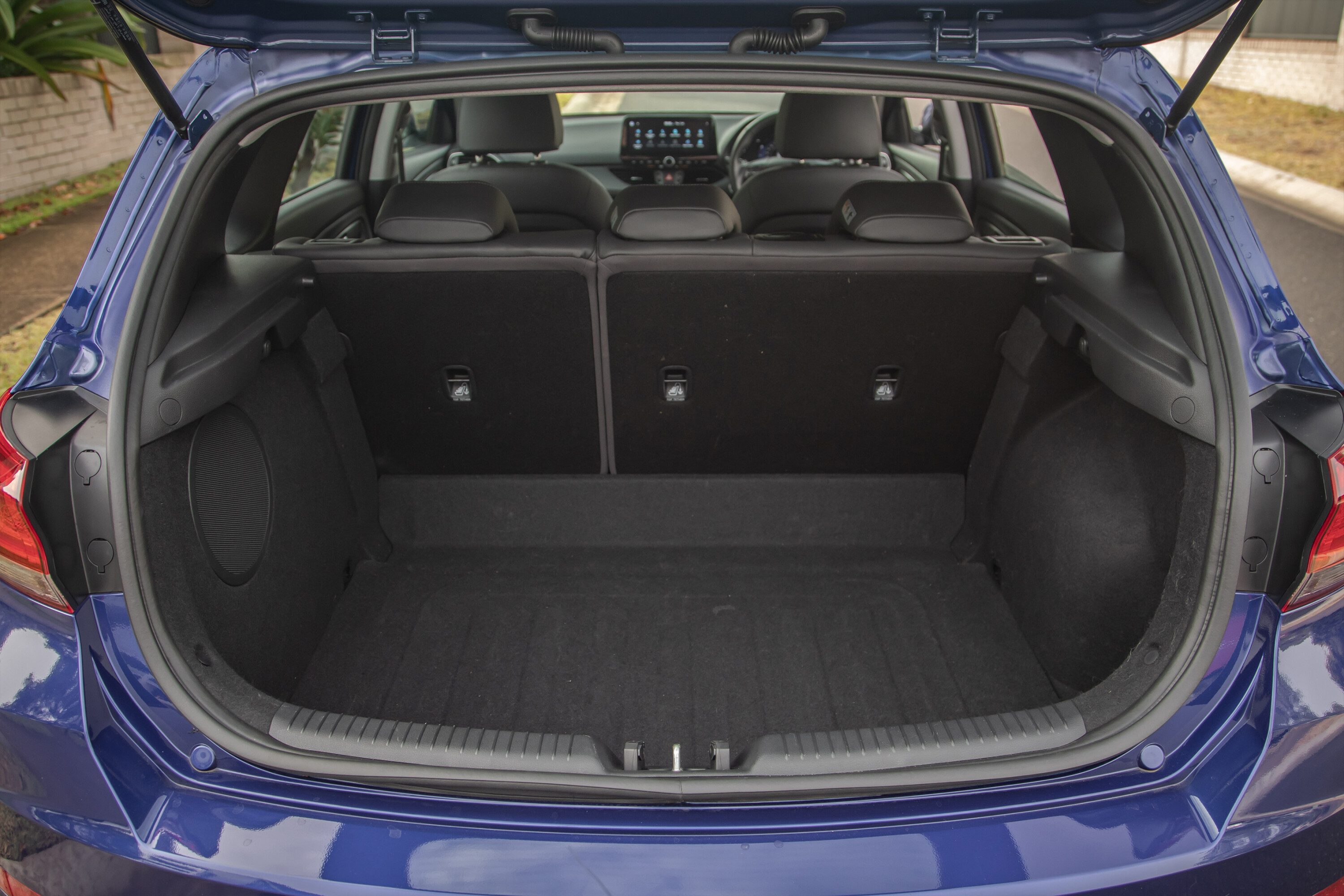
How much boot space does the Hyundai i30 offer?
The five-door i30’s cargo area is 395 litres, which is good for a small hatchback.
Its rear seats can be folded 60:40 and folding the lot down brings an impressive 1301 litres in which to carry stuff.
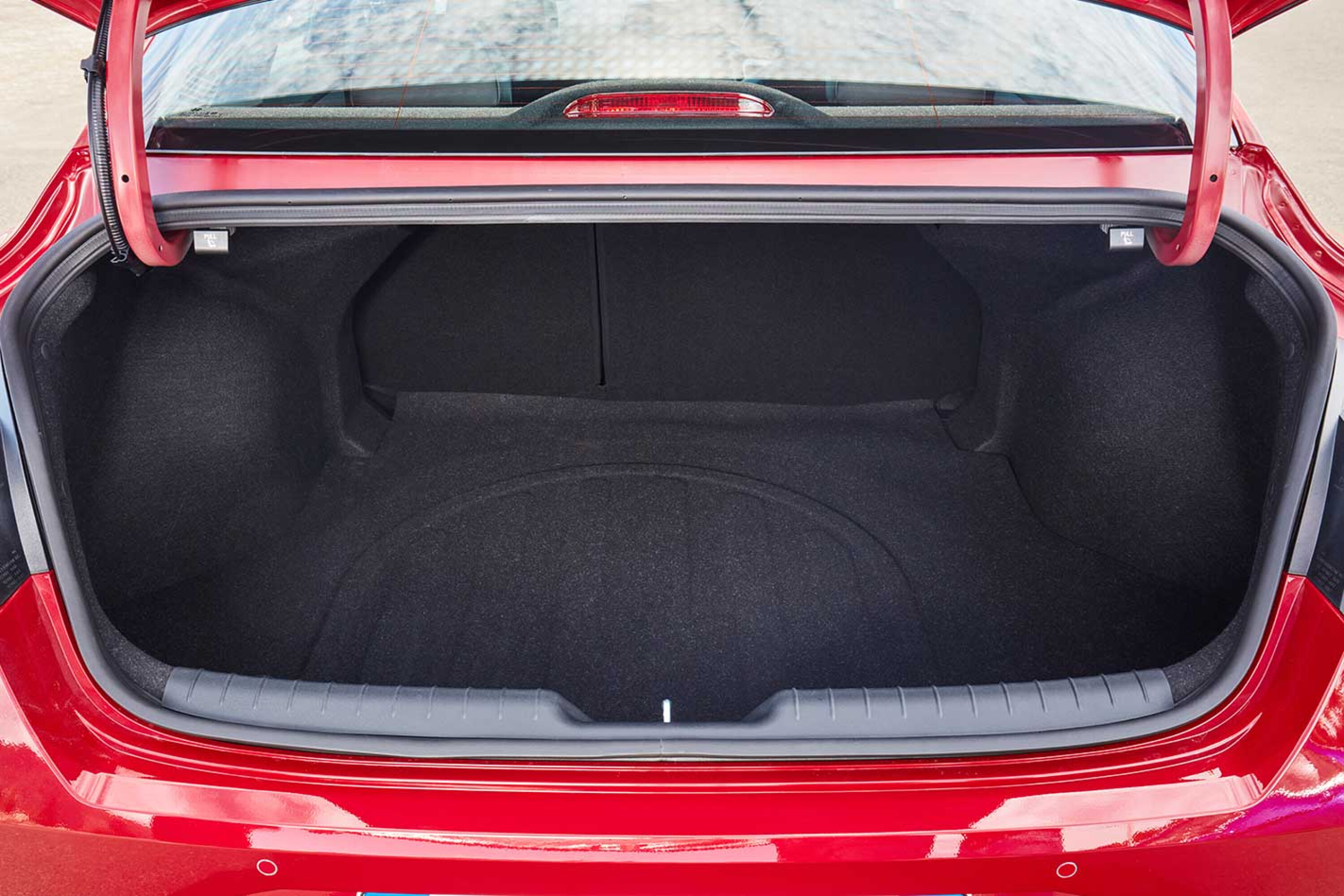
Even with the full-size spare wheel, you can adjust the height of the boot floor. At its lower setting, capacity is maximised but there is a large step up to the rear of folded seatbacks. Raising the floor gives you a flatter extended load space.
You’ll score more boot storage in the i30 Sedan, which offers 474 litres.
There is a huge aperture that allows for bulkier items to protrude into the cabin through the 60:40 split seats.
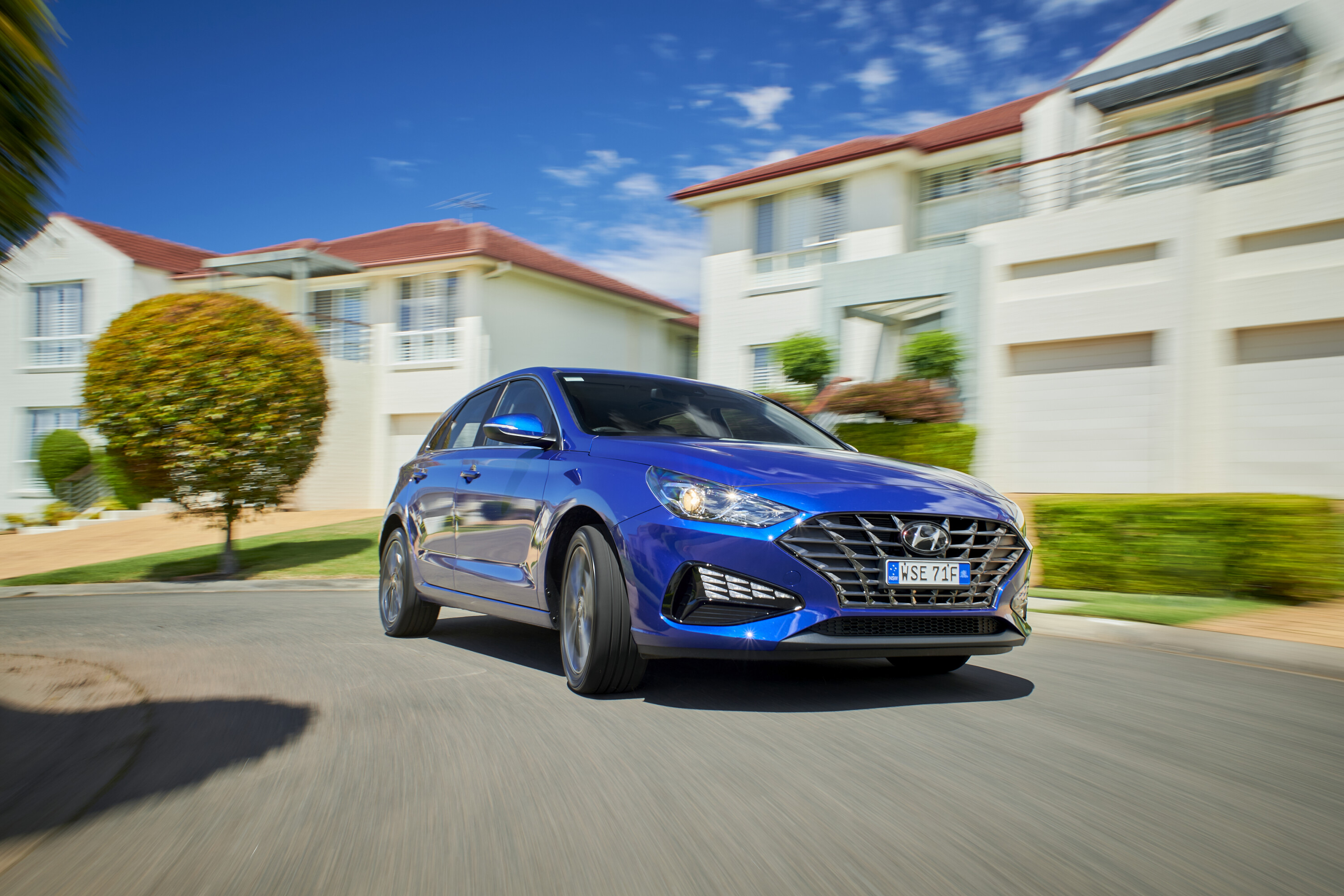
I like driving, will I enjoy the i30?
One of the reasons this third-generation i30 has been so impressive from launch is that it drives really nicely.
While the entry-level 2.0-litre petrol engine is hardly what you’d call characterful or exciting, it does the job quietly, whether hooked up with the well-sorted six-speed automatic transmission or six-speed manual.
The ride is comfortable and smooth and if you find yourself on a twisty road you’ll enjoy its decent balance and accurate steering.
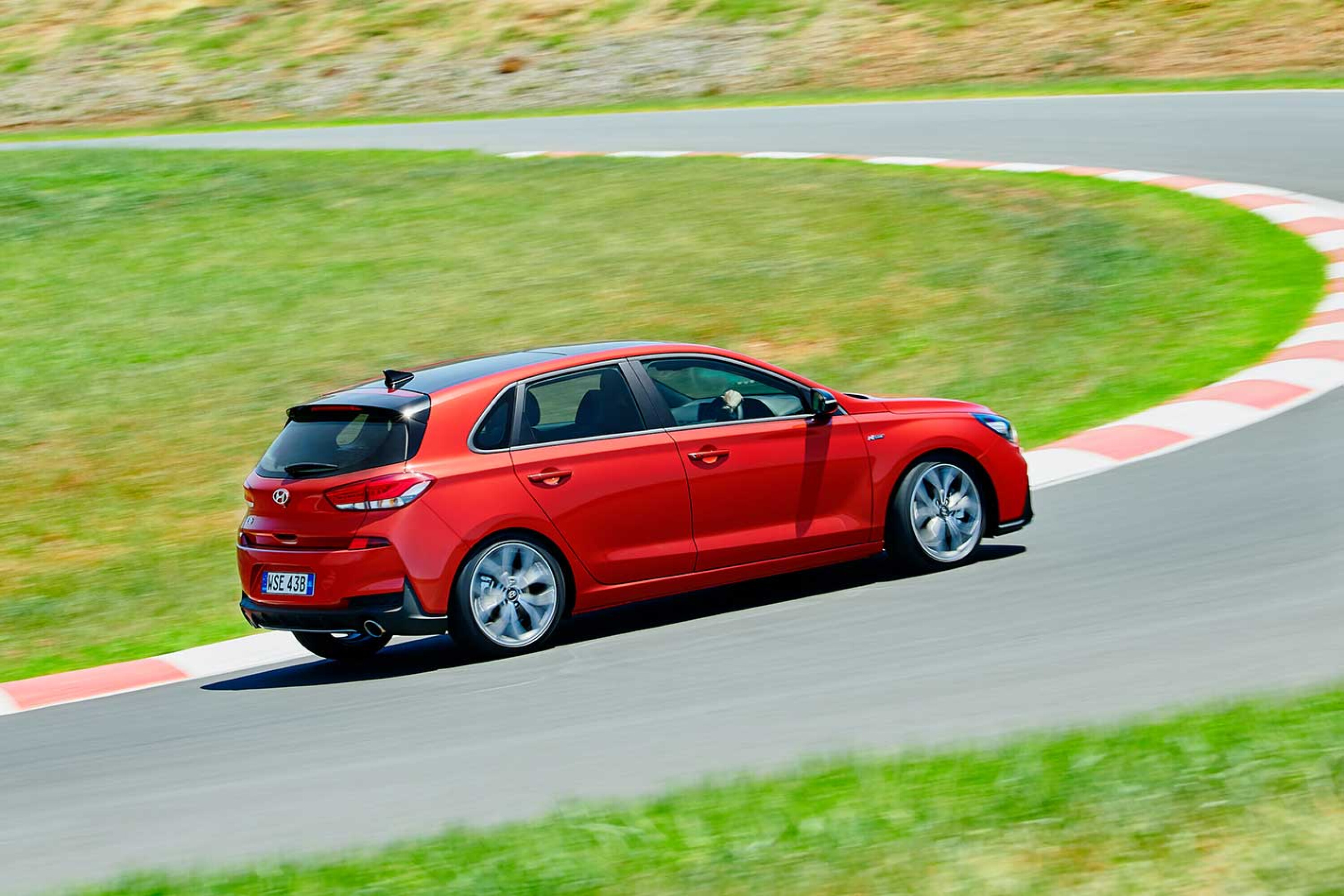
If you’re a keen driver, a stretch to the sporty N-Line is worth the extra coin, with its sporty Michelin tyres and multi-link rear suspension setup in place of the more basic torsion beam setup found in regular i30s.
The 1.6-litre turbocharged engine brings feisty acceleration and a hint of hot hatch, albeit minus a rorty exhaust note.
Although the N-Line isn’t a hardcore sports model, it brings more excitement than most popular small cars and is the most engaging of the range if you leave the i30 N out of the equation.
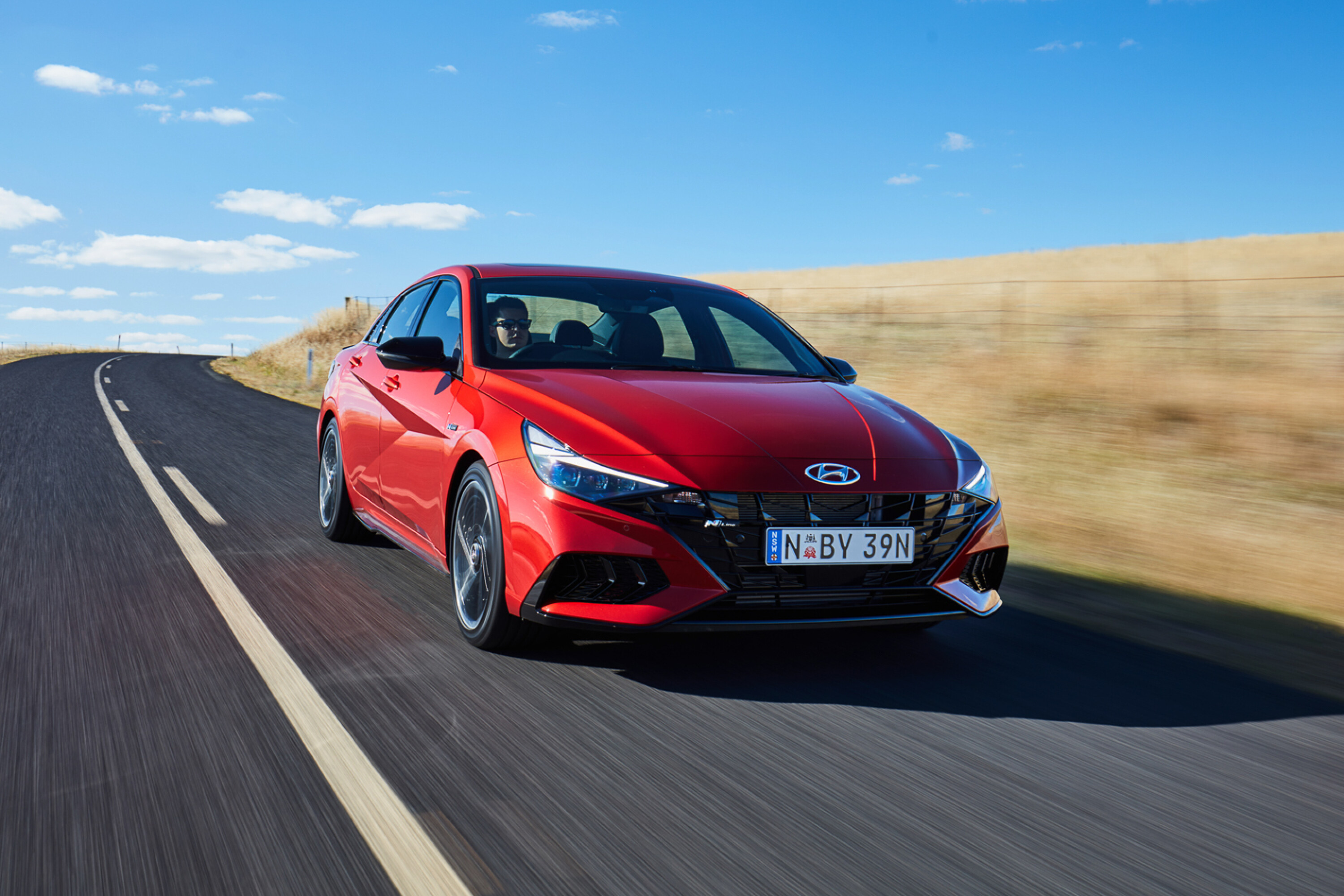
All of the above mostly applies to the i30 sedan, the difference being the new K3 platform that brings improved chassis stiffness resulting in even better ride quality.
But If you really take your driving seriously, the 206kW/392Nm 2.0-litre turbo-powered i30 N is for you!
The N’s manual gear shift action is incredibly slick and is augmented by rev-matching tech that eliminates the need to heel-toe when braking hard.
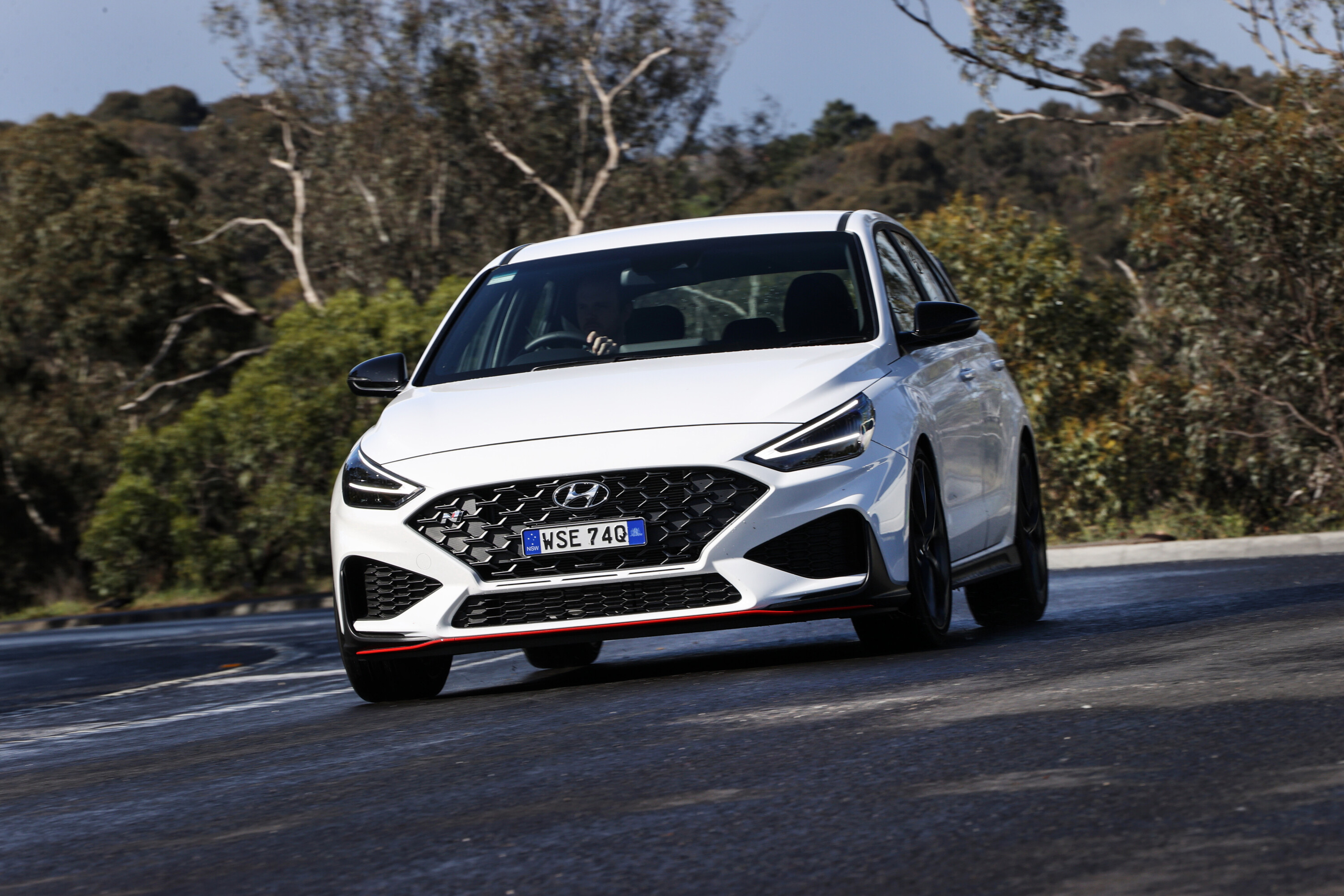
Matched with the eight-speed dual-clutch automatic transmission, it’s an incredibly capable and efficient car to cover ground in.
At speed, shifts are solid and frenetic yet it remains smooth and largely seamless around town.
Straight-line performance is exceptional, with plenty of thrust and minimal turbo lag when you put your foot down. And on bends there’s plenty of grip with handling tuned to deliver high-speed stability.
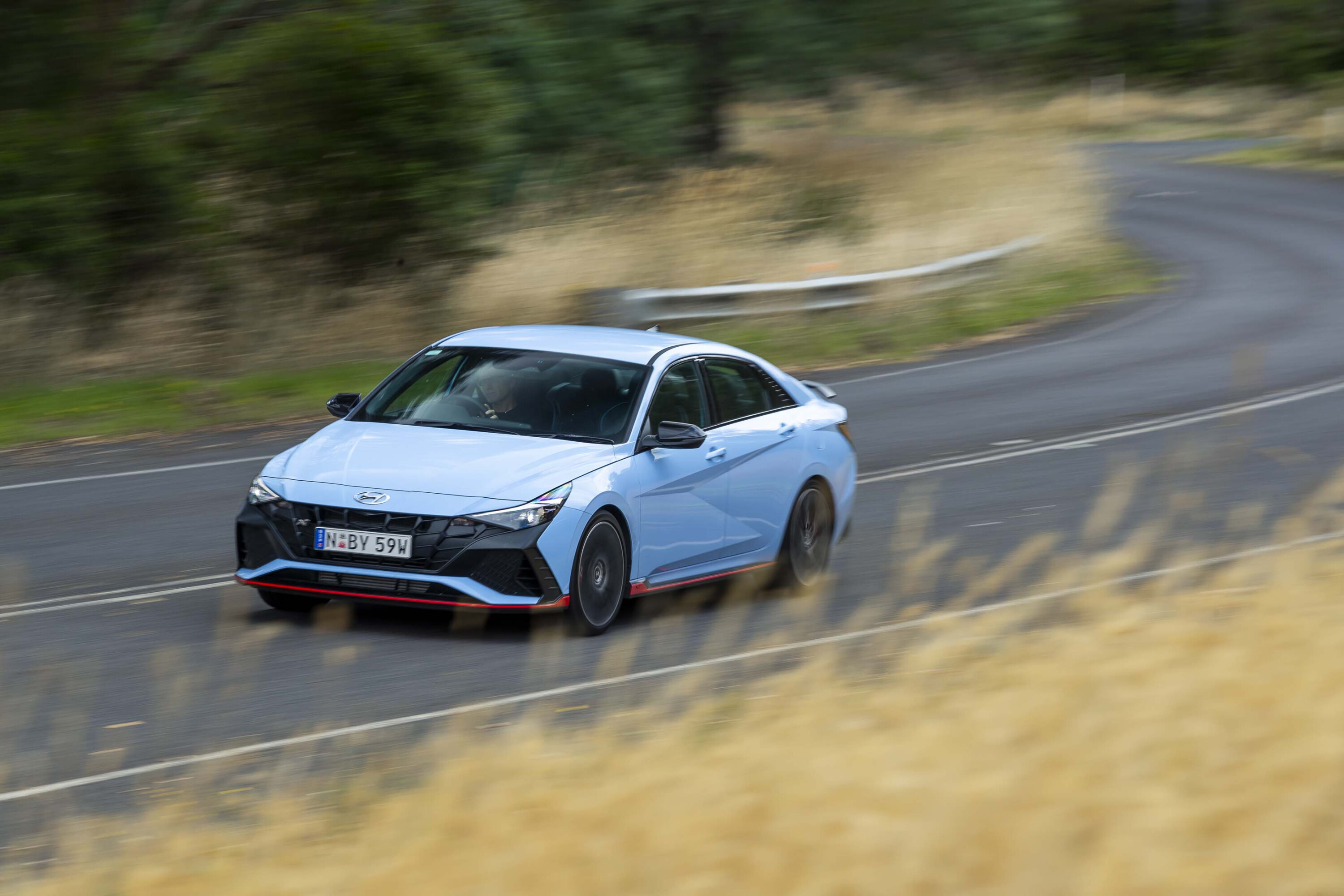
Another smile-inducing aspect of the i30 N is its soundtrack.
With the exhaust valves opened all the way, the engine offers up a delightful crackling noise that makes you think you’re driving one of Hyundai’s rally cars.
If any of the terms in this section have left you scratching your head, these articles will help bring you up to speed!
- What is a Powertrain or Drivetrain?
- Power vs torque
- Car suspension explained
- Automatic transmissions (‘gearboxes’) explained
- Chassis control systems explained
- Car vs Ute vs SUV: How the vehicle you buy should guide the way you drive
Which Hyundai i30 engine uses the least fuel?
In real-world conditions, little separates the 2.0-litre petrol and 1.6-litre turbo-petrol powertrains when it comes to fuel economy.
But, if you’re a stickler for official numbers and like calculating things down to the decimal, you’ll find small differences in fuel economy depending on whether the engine is in a hatchback or sedan, or coupled with a manual or automatic transmission.
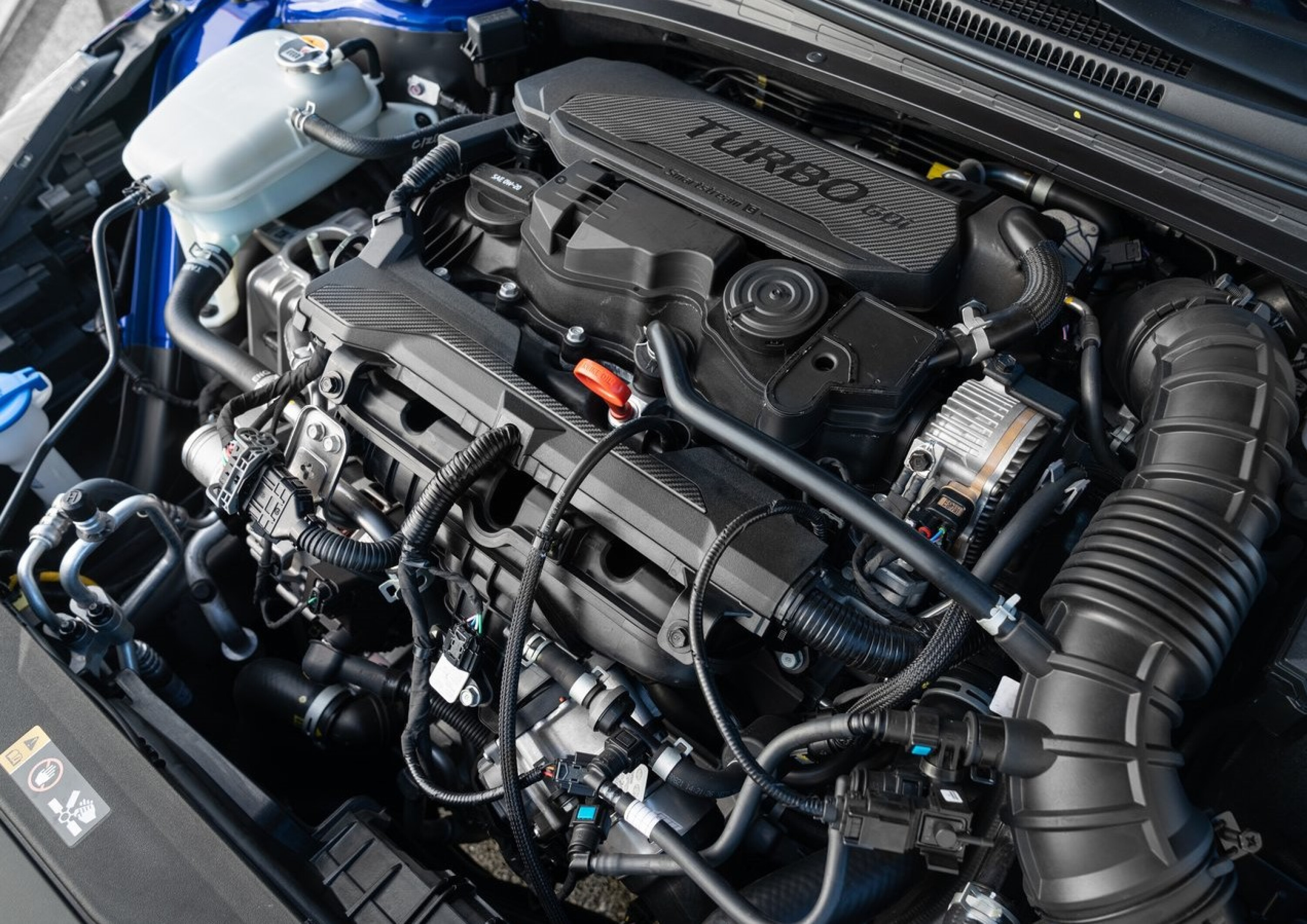
The thriftiest powertrain is the N-Line sedan‘s 150kW/265Nm 1.6-litre four-cylinder turbo with seven-speed DCT, which officially consumes 6.8L/100km combined cycle – though this is unlikely in real life if the N-Line is driven in the spirit in which it is intended.
In the N-Line hatchback, this same combination consumes 7.1L/100km while manual N-Line sedans and hatchbacks consume 7.5L/100km.
As for the rest:
| Engine | Transmission | Variant | L/100km |
|---|---|---|---|
| 1.6L turbo | 7-speed DCT | N-Line sedan | 6.8 |
| 2.0L | Manual/auto | Active/Elite sedan | 7 |
| 1.6L turbo | 7-speed DCT | N-Line hatch | 7.1 |
| 2.0L | Manual/auto | i30/Active/Elite hatch | 7.5 |
| 1.6L | 6-speed manual | N-Line sedan/hatch | 7.5 |
| 2.0L twin-turbo | Manual/8-speed DCT | N sedan | 8.2 |
| 2.0L twin-turbo | Manual/8-speed DCT | N hatch | 8.5 |
A reason the sedan variants are more efficient is their newer ‘Smartstream’ engines, which are updated versions of the hatchback’s standard 2.0-litre and 1.6-litre GDi donks.
Curiously, the new 117kW/191Nm 2.0-litre in the i30 Active and Elite sedans produces 3kW and 9Nm less power and torque than the 2.0 GDi, while bringing nothing obviously new in terms of technology.
What is the Hyundai i30’s towing capacity?
The standard 2.0-litre i30 hatchbacks have a handy 1300kg/600kg braked/unbraked towing capacity with either transmission, while the sedans can pull 1200kg/610kg.
A 1.6-litre turbo N-Line hatch also pulls 1300kg/600kg, while an N-Line sedan can tow 1200kg/610kg with the manual gearbox or 1100kg/610kg with the DCT.
Each of the above variants has a 75kg maximum tow ball weight.
The i30 N does not have towing capacity figures; truth be told, it would be a travesty to fit one with a towbar.
How long is the warranty and what are the Hyundai i30’s servicing costs?
All Hyundai i30s, including the racy Ns, are covered by the company’s five-year / unlimited-km warranty, along with an initial 12 months of roadside assistance – extending by a year every time you service at a dealer.
Standard i30 variants including the N-Line, have service intervals of 12 months or 15,000km. Hyundai offers prepaid servicing priced at:
| Hyundai i30 pre-paid servicing price | Terms |
|---|---|
| $897 | 3 years/45,000km |
| $1196 | 4 years/60,000km |
| $1495 | 5 years/75,000km |
The i30 N has 12-month/10,000km service intervals with prepaid servicing costing:
| Hyundai i30 N pre-paid servicing price | Terms |
|---|---|
| $1005 | 3 years/30,000km |
| $1345 | 4 years/40,000km |
| $1675 | 5 years/50,000km |
Which version of the Hyundai i30 does Wheels recommend?
Unless you’re in the market for a hot hatch (or sedan) and can afford the i30 N, the i30 N-Line with the seven-speed DCT is great buying. You get a lively turbocharged engine and a lot of equipment, including the SmartSense active safety suite.
And while it doesn’t have the N’s stonking performance, it offers an enjoyable ‘warm hatch’ experience, while being a very comfortable daily driver.
The sedan offers a fresher package and crisper handling, but you are unlikely to regret opting for the hatch and saving $2000.
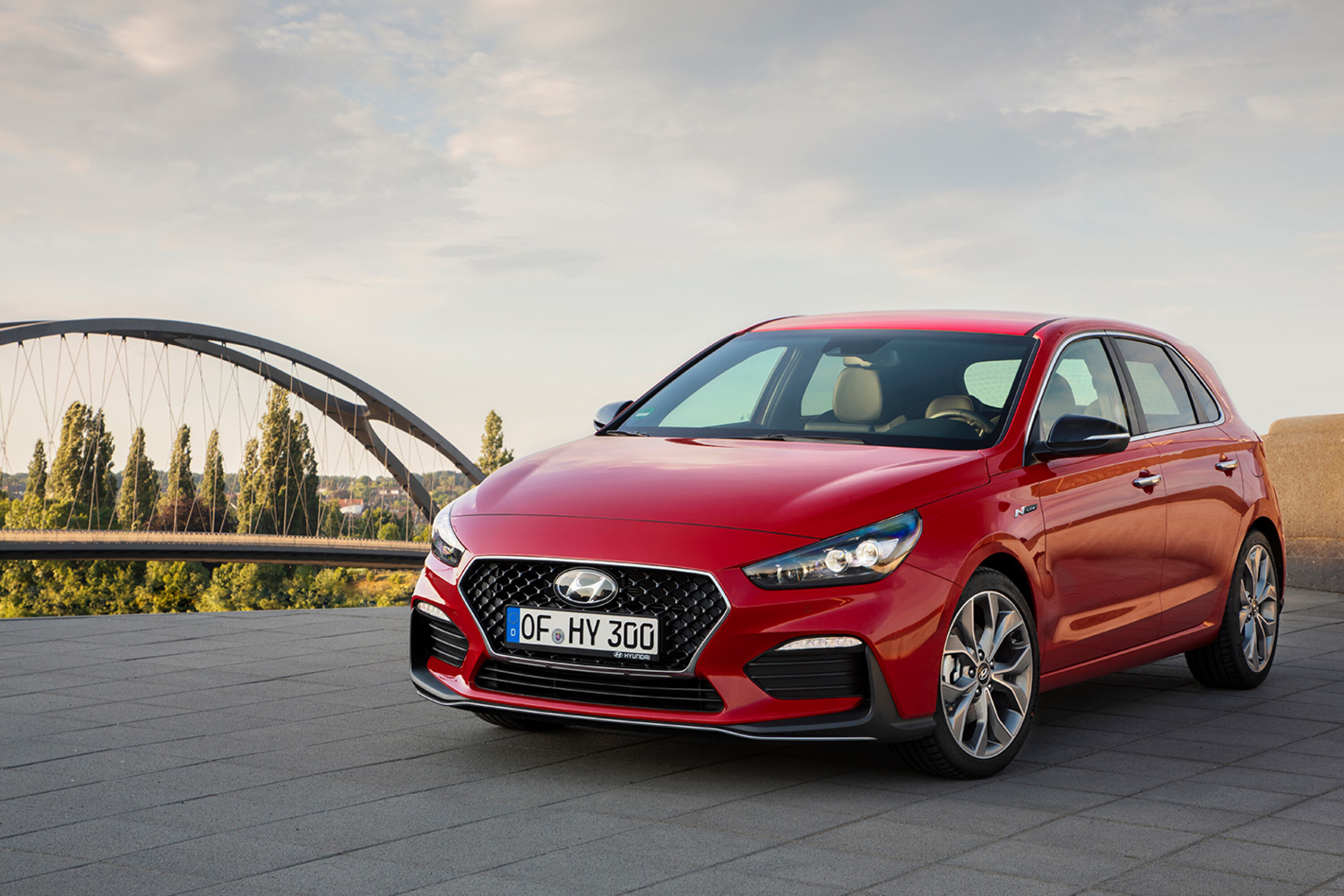
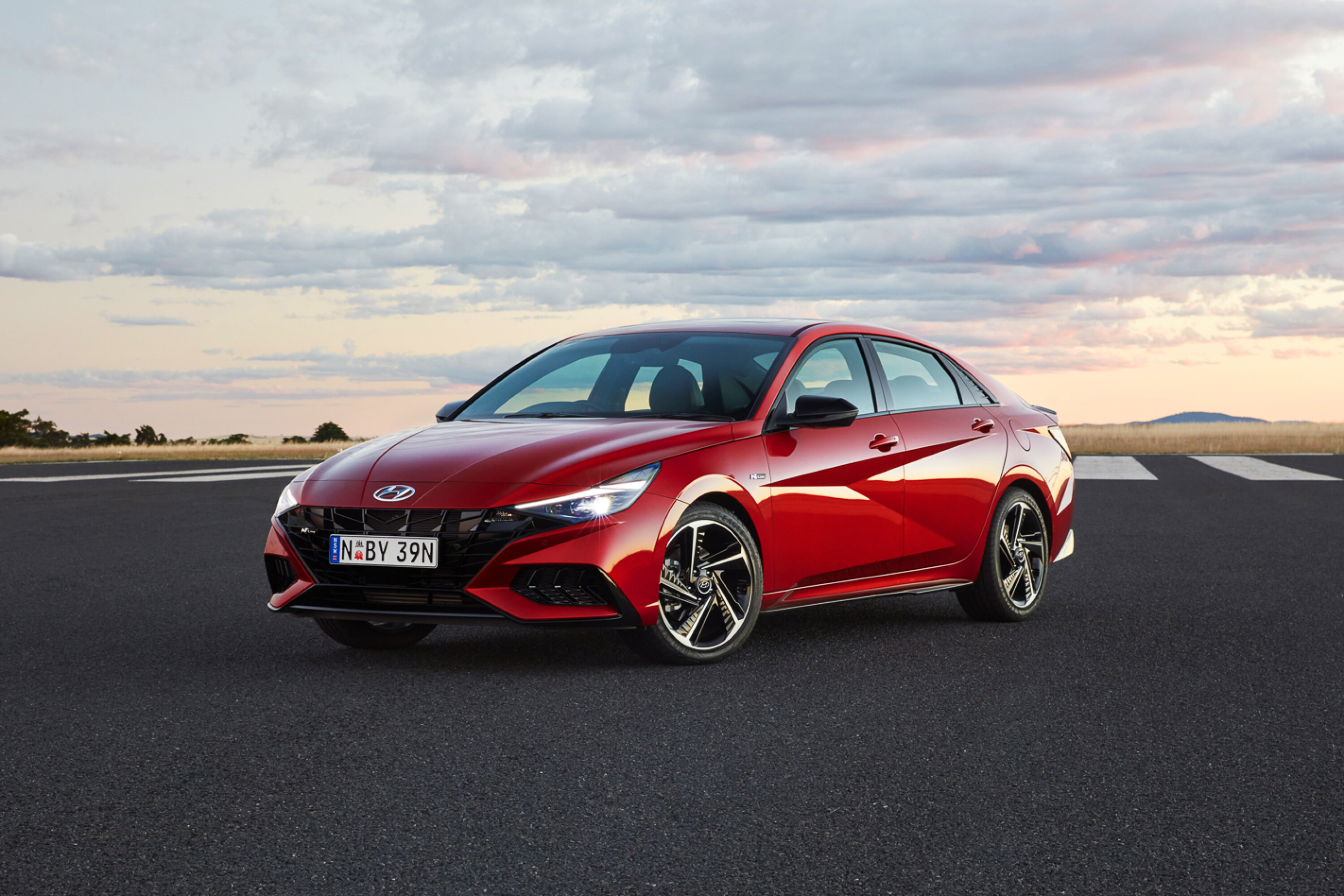
What are the Hyundai i30’s key rivals?
Hyundai i30 N rivals
ud83dudd3c Back to topMore guides to help you choose the best car & tyres for your needs
- All tyre news & reviews
- Longest warranties & capped-price servicing period
- Buy new or used?
- Best cars for your teenager
- Must-have features for new drivers
- Active safety tech explained
- Australian road rules explained
- Does driving slower save fuel?
- Does my car need the pricier fuel?
- Help, I’ve used the wrong fuel!
- What is a hybrid car?
- How long do tyres last?
- What shoes should I wear to drive?
- What to do after buying a new car
- How much does LCT add to a car’s price?
- The ‘check engine’ light just came on…
- Is it illegal to drive too slowly in Oz?
- FWD v RWD v AWD – which is safer?
- How much can my large SUV tow?
Score breakdown
Things we like
- Ride and handling
- Smooth powertrains
- N-Line and N performance
- Manual gearbox not confined to entry-spec
Not so much
- Tight rear legroom
- No wireless Android Auto/Apple CarPlay
- Lacks some of the newer active safety features




